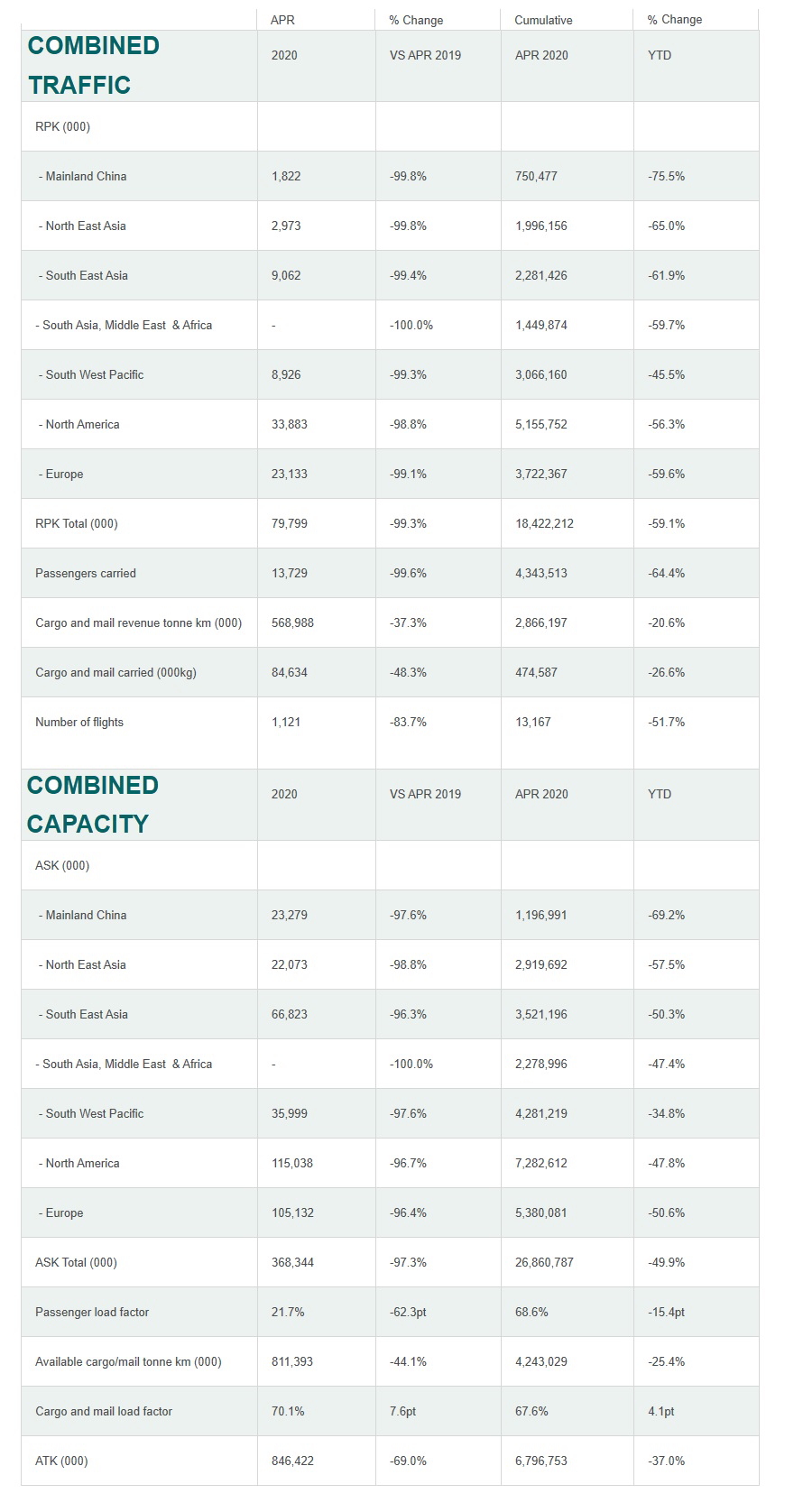|
Cathay Pacific and Cathay Dragon carried 13,729
passengers last month, a decrease of 99.6% compared to April 2019.
The month�s RPKs fell 99.3% year-on-year, whilst the passenger
load factor dropped 62.3 percentage points to 21.7%. Capacity, measured in available seat kilometres
(ASKs), decreased by 97.3%.
In the first four months of 2020, the
number of passengers carried dropped by 64.4% against a 49.9%
decrease in capacity and a 59.1% decrease in RPKs, as compared to
the same period for 2019.
Ronald Lam, Cathay Pacific Group Chief Customer and Commercial
Officer, said, �The COVID19 pandemic continues to
impact us in an unprecedented way. Year-to-date up to April, we
made an unaudited loss of HK$4.5 billion at the full-service
airline level (Cathay Pacific and Cathay Dragon) and the financial
outlook continues to be very bleak for the coming few months at
least ... We operated only a bare skeleton passenger flight
schedule serving just 14 destinations in April. Passenger demand
continued to fall during the month and we carried fewer than 500
passengers per day only. The ban on transit traffic through Hong
Kong together with minimal demand for outbound travel meant that
the majority of our very limited traffic came from inbound
travellers, notably from North America and the UK.�

The two airlines carried 84,634 tonnes of cargo
and mail in April 2020, a decrease of 48.3% when compared to April 2019.
The month�s revenue freight tonne kilometres (RFTKs) fell 37.3%
year-on-year, whilst the cargo and mail load factor increased by 7.6
percentage points to 70.1%. Capacity, measured in available
freight tonne kilometres (AFTKs), was down by 44.1%.
In the first
four months of 2020, the tonnage fell by 26.6% against a 25.4%
drop in capacity and a 20.6% decrease in RFTKs, as compared to the
same period for 2019.
�Overall tonnage uplift in April dropped by almost
a third compared to the previous month, it being particularly
impacted by the further contraction of our belly capacity across
our passenger network. The movement of certain cargo, such as
perishables, seafood, live animals, industrial parts and
equipment, was also negatively affected by lockdown measures
around the world. Nevertheless, we continued to carry significant
quantities of medical supplies from mainland China and Hong Kong,�
said Mr. Lam. �Significant effort was made to prioritise
capacity for routings with the highest airfreight demand, most
notably to the Americas, Australia and Europe. We also increased
the utilisation of our existing freighter fleet, chartered more
flights from our subsidiary Air Hong Kong, and successfully
operated over 500 pairs of cargo-only passenger flights � more
than double the number we operated in March. To further expand our
available capacity, at the end of April we began loading cargo in
the cabins of our Boeing 777 passenger aircraft, which we expect
will serve long-haul markets especially well in the months to
come.�
Outlook
IATA's updated analysis of global aviation indicates that the COVID19 crisis
will see global airline passenger revenues drop by US$314 billion
in 2020, a 55% decline compared to 2019. Airlines in Asia Pacific
will see the largest revenue drop of US$113 billion and a 50% fall
in passenger demand year-on-year.
Mr. Lam said, �Industry bodies and analysts are now
predicting a much more prolonged recovery for the global aviation
industry, with international travel expected to pick up more
slowly than domestic travel as border restrictions are only
gradually eased. It is widely expected that international travel
demand will only return to pre-COVID19 levels in a few years.
�As Hong Kong�s home carriers, we do not have the
benefit of a domestic passenger network as a buffer. We already
announced that we will continue to operate a minimal schedule over
the next two months. Although it is our intention to slightly
increase our passenger flight capacity from 3% in May to 5% in
June, these are still subject to a potential relaxation in
government health measures.
�At this stage, we still see no immediate signs of
improvement. We expect that our average daily passenger numbers
will remain at around 500 in May, and that business and leisure
travel will remain severely impacted for the foreseeable future.
Overall, we do not anticipate we will see a meaningful recovery
for an extended period.
�This is the biggest challenge to aviation we have
ever witnessed. We are evaluating all aspects of our business to
ensure that we remain strong and competitive when we emerge from
this crisis. The world has changed dramatically over the past few
months and it is imperative that we do everything in our ability
to adapt to this new world in order to secure our future within
it.�

See latest
Travel News,
Video
Interviews,
Podcasts
and other
news regarding:
COVID19,
Cathay Pacific,
Hong Kong,
RPKs,
ASKs,
FTKs.
|
Headlines: |
|
|
